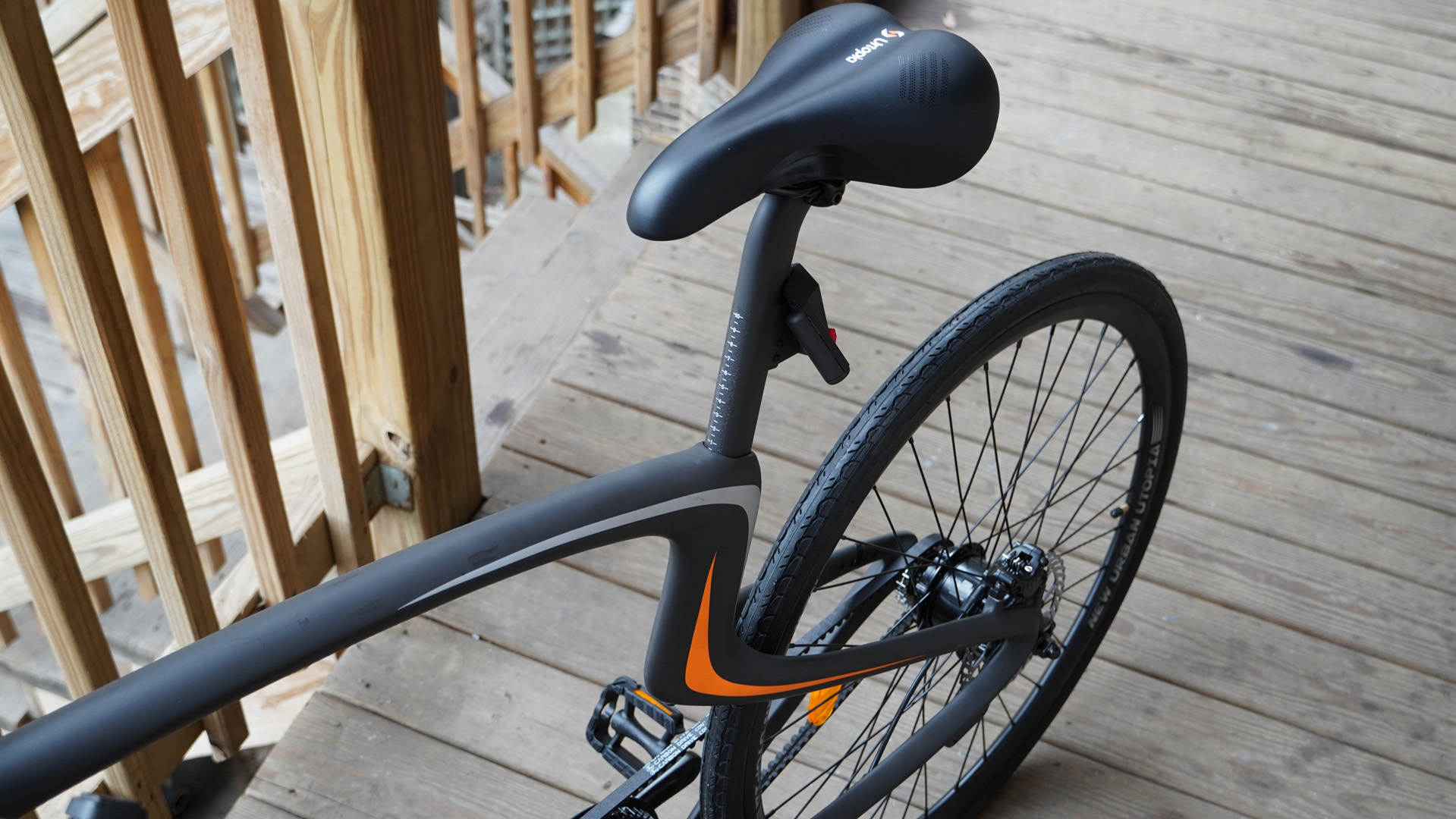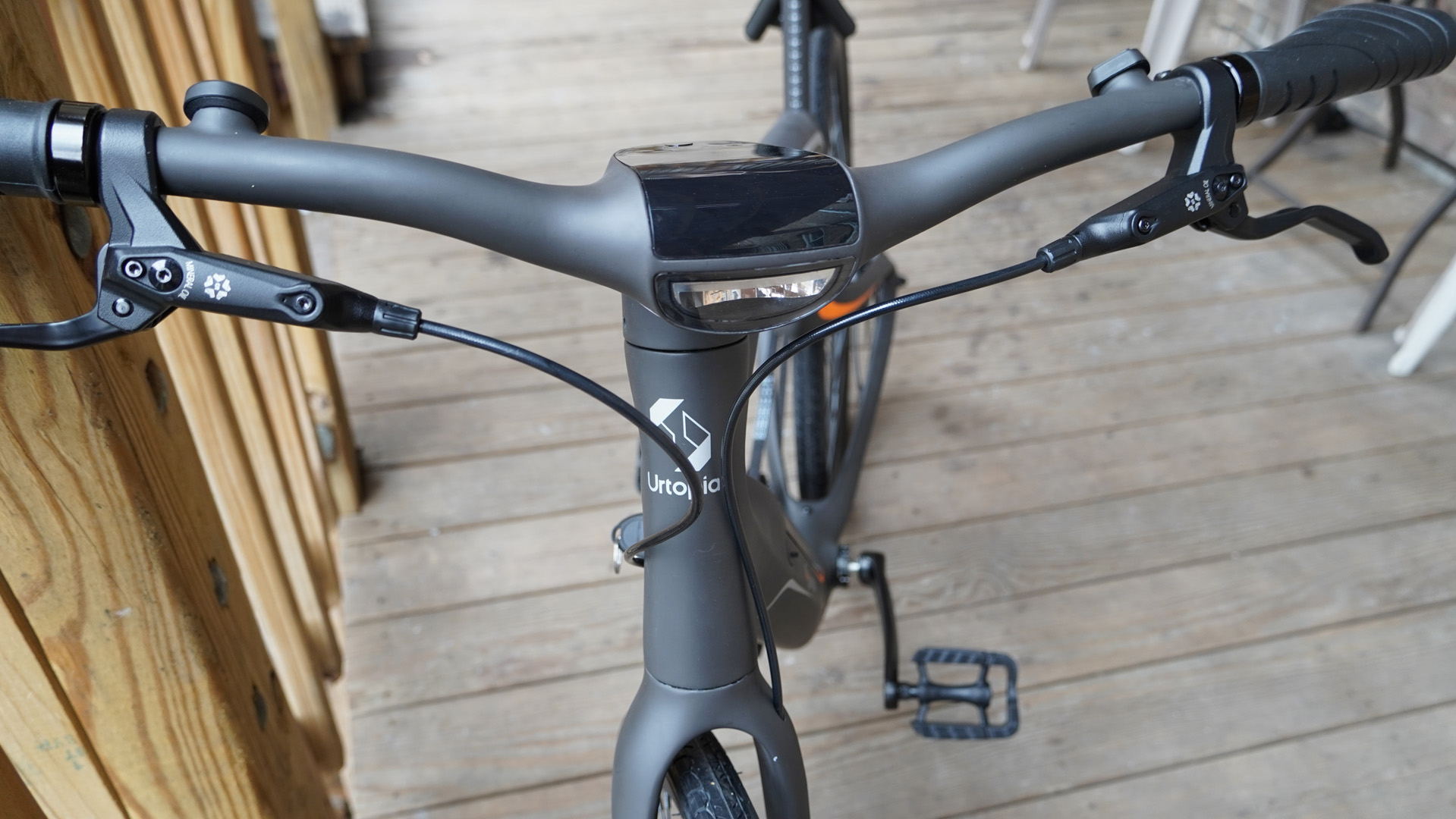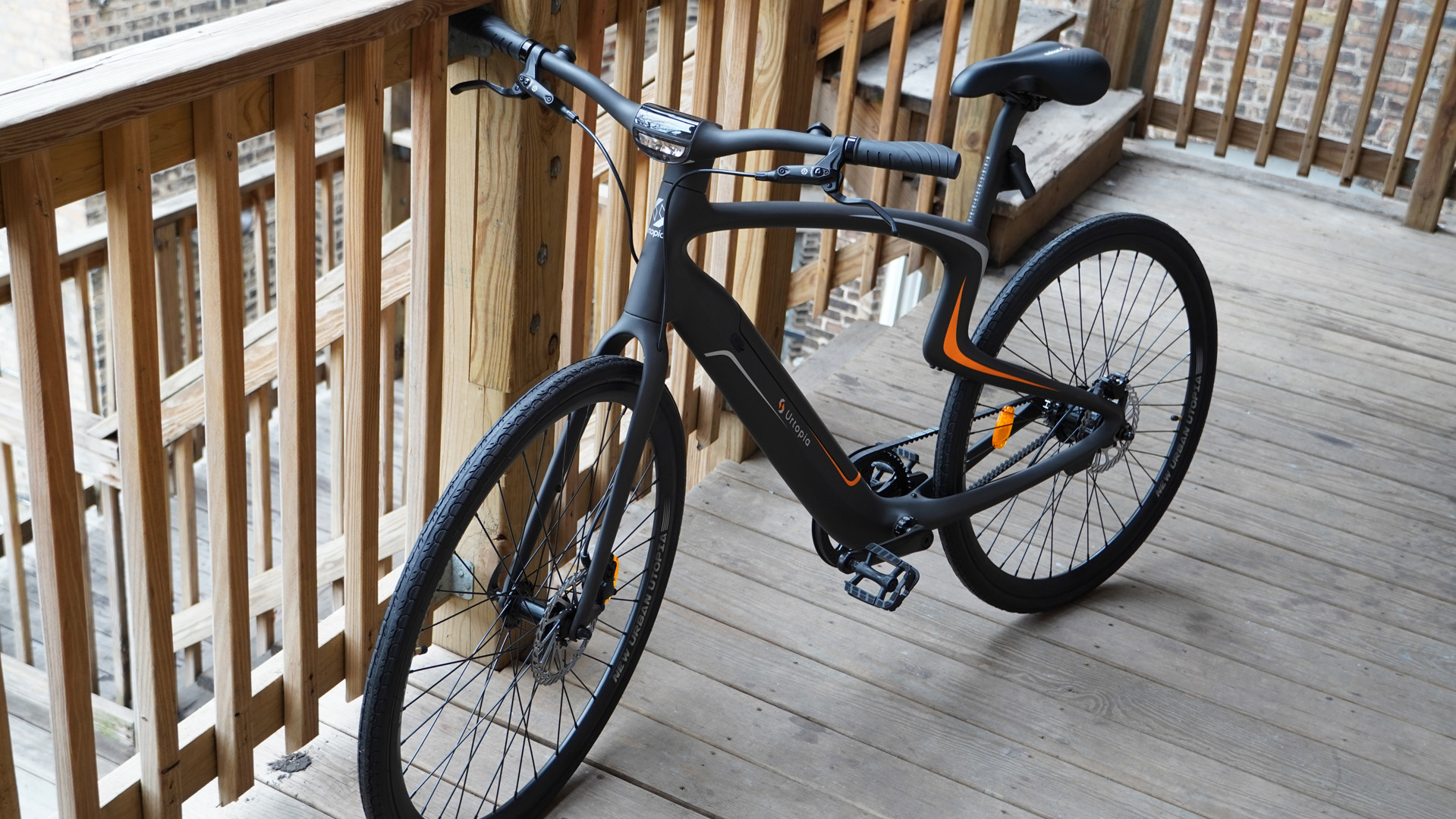Urtopia ebike review: a carbon electric bike that promises beyond what it delivers
The Urtopia provides and unique design and promises to redefine the ebike but its features somehow don’t live up to the hype

The Urtopia starts with a promise of a lightweight ebike thanks to a carbon fiber frame and then piles on some fancy-sounding features, but very little of it is up to snuff, and cheaper bikes are managing to do better in almost every way.
-
+
Stylish frame
-
+
Some quality components
-
+
On the lighter side
-
-
Lacking performance
-
-
Proprietary elements
Why you can trust T3

Urtopia Carbon - Key Specs
Size range: Medium (Rider Height Range 5'5"-5'11"), Large (Rider Height Range 5'9"-6'5")
Motor: 250W, 35N⋅m, rear hub,
Top speed (motorized): 20mph (US), 16mph (EU)
Power: 36V 9.8ah (360Wh) Samsung lithium battery
Control: Torque-sensor pedal assist
Ebike classification: Class 1
Speeds: Single-speed
Brakes: dual-piston hydraulic disc brakes
Frame material: Carbon Fiber
Fork material: Carbon Fiber
Wheel size: 700x35c
Weight: 30 pounds (listed); 33.6 pounds (measured)
Max. load: 240 pounds
Range: 30-80 miles
Safety features: GPS tracking, movement alerts, locking battery, fingerprint unlock, rear-warning system, digital bell, locking battery pack
The Urtopia ebike is a brand-new entrant to the electric bike market, aiming to deliver a package that outdoes its competitors in a stylish, somewhat affordable, and (most importantly) lightweight package.
The carbon fiber frame, fork, handlebar and seatpost allow for a unique design that doesn’t conform to some of the more classic double-triangle style frames you’ll see elsewhere. It gives the Urtopia carbon ebike its signature look while letting it come in at close to 30 pounds. That’s definitely on the light side for an ebike, and difficult for many bike makers to get past given the added weight of a motor and battery is unavoidable.
Urtopia promises a lot from its bike with a design that’s backed up with a bunch of smart features, yet while it talks the talk, it doesn’t always walk the walk. There’s just so much going on with this bike that it's almost easy to overlook the many spots the Urtopia stumbles, at least until you actually start using it.
I tested the Urtopia on the streets and bike paths of Chicago, taking in many of the same routes that I do on a daily basis, both on my own wheels and various other test bikes. For more information on how we review ebikes, visit the T3 how we test page.
URTOPIA REVIEW: price and availability
The Urtopia ebike was originally available through IndieGogo but earlier this year it transitioned to regular sales from its website. The bike is priced at $2799 (roughly £2250 or AU$4000) though is only available in the US and through its website, with models expected to start shipping by June 2022.

URTOPIA REVIEW: DESIGN AND FEATURES
There’s no mistaking the Urtopia for anything but a special bike. It’s still a 700C road bike but the frame is entirely unique, with a lightning-bolt-shaped top tube that bends into a small section of seat post and then down to seat stay. The result looks great and certainly turns heads. The down tube is thicker to accommodate a streamlined battery pack that locks into place and powers this ebike.
The special design stems from the construction, which is largely carbon fiber. The entire frame, the fork, the handlebars, and the seat post are all carbon fiber with a slick matte finish. Usually, carbon fiber is found on top-of-the-line bikes due to its low weight and high strength. The Urtopia is actually fairly cheap for a carbon fiber model, but the finish here also seems to scrape and blemish really easily.
Get all the latest news, reviews, deals and buying guides on gorgeous tech, home and active products from the T3 experts
The frame claims to support a max load of 240 pounds, which isn’t the pinnacle of strength, and the fully assembled bike actually weighs in at 33.6 pounds, a full 3.6 pounds heavier than advertised — that’s no small variance in an industry full of people who will go to extreme lengths just to shave a few grams off the weight of their bike.
Urtopia didn’t put all its eggs in the carbon basket, though. It’s aiming to provide a smarter ebike as well. The bike has a built-in smart headset, housing a dot-matrix display, dual mics, a 3W speaker, vibration motors, and a front headlight. The tail of the bike also houses a taillight, an “Advanced Rear Early-indication System” (ARES), and a pair of projection turn indicator lights that shine down onto the road. Controls for the bike are integrated into the handlebars with a single thumb button on the right side and a four-way directional pad on the left.
These smart features sound good on paper, but don’t hold up in real life. Voice controls sometimes work, sometimes don’t. The digital bell doesn’t ring out as clearly as a real bell, and it sometimes comes after a delay. The fingerprint reader built into that same button also fails more often than it registers. The dot-matrix display is cool to look at for a minute until you realize it’s actually incredibly low-resolution and can’t provide much detailed information. The turn indicators are dazzlingly dim, and shining them onto the ground feels like a good way to ensure cars don’t see them. Meanwhile, the ARES system proves hard to rely on.
There are some smarter features in store, such as an eSIM connection and GPS tracking, but at the time of testing neither of these features seemed enabled. I believe the bike’s locking and security alarm features are supposed to be available at present, but locking the bike with the keypad didn’t prevent me from picking it up and carrying it off without it making a peep. (Update: After a firmware update, the alarm would trigger shortly after moving the bike if it had been locked with a voice command, but didn’t react if it had been locked with the buttons).

The bike pairs with an app, but so far it just shows some route tracking data and allows for unlocking the bike, setting up the fingerprints, and updating firmware. The app needs a lot more work, though, as it doesn’t do much to interface with the bike (not even showing a battery level) and presents some absurd information (suggesting I burned 18,774 Calories and saved 13.12Kg of CO2 over a 16.5-mile ride).
All of these smart features, for whatever they're worth in use, seem to come at a considerable cost in price and battery. After charging the battery to 100% early in the week, powering it on for a ride on a Friday found the battery below 50% charge. The headset was warm to the touch, suggesting it had some internal processing active. A little idle battery drain isn’t unheard of, but losing most of a charge in just a couple days while the bike is sitting unused isn’t ideal. One solution would be to leave the battery off of the bike until it’s time to ride, but that’s not the type of inconvenience I’d expect from a premium, smart product.
Urtopia gains back some ground by offering a few premium parts. The handgrips offer decent ergonomics. The hydraulic disc brakes, though from an unnamed brand, came well-tuned out of the box. And there’s Gates belt drive transmission.
Much of the design is proprietary, which will make swapping out parts or getting replacement parts a gamble, and it doesn’t have ways to support baskets, bottles, or the like. Some parts can be swapped out, though, like the handlebar grips, pedals, and saddle. The saddle is slim and modestly cushioned, but the pedals feel like an afterthought, with a cheap plastic build and almost no grip.

URTOPIA REVIEW: PERFORMANCE
The Urtopia ebike is geared to make biking easier for its rider, rather than being about pure power and speed. The 250W motor is triggered by a torque sensor, which sees it come on and offer an assist more responsively than a typical cadence sensor, which requires some more pedal rotation before it’ll get the motor spinning.
There’s not a lot of pickup from the motor, but it does a fine job boosting from low speed up to the bike’s top speed of 16mph. The US model is intended to reach 20mph, but my test model was limited to 16mph. The motor assistance is important, as the bike isn’t very well geared for unassisted riding — something that’s been true to varying degrees of every ebike I’ve tested. Thankfully, the motor does the job. Curiously, the bike felt more or less the same regardless of whether I had it at its lowest power level or its highest — ignoring the “pedal” mode which is a sneaky way of saying the motor is off.
Overall, the ride is decent. The frame’s not so stiff as to leave me sore after the end of some long riding. I couldn’t entirely gauge the comfort of the bike as Urtopia would only ship a Medium review sample, and given the fixed handlebar position (remember, you can’t change it) and shorter seat tube, there is less room for adjustment than on regular frames if you are taller or shorter than average.
I took the Urtopia out on a nice spin across town to get lunch. Even though the weather soured with a constant drizzle as soon as I set out, the bike proved up to the task of rolling onward without issue in the wet. In spite of my being a bit too large for the bike and on the high end of its weight limit, I was able to cruise along leisurely enough on city streets and some paved trails.

The speed limit of the bike is noticeable after coming from some Class 3 ebike that go up above 20mph, but casual riders will likely be more than satisfied with the 20mph cap (which I trust Urtopia will deliver). It won’t be easy to go faster for those who want to, though, as the factory pedals aren’t grippy enough to trust with hard pedaling up out of the saddle.
The brakes are about the best safety feature on the bike. Even going full speed, I was able to stop in a single car length. Cruising along a two-lane road on my ride home, I tested out the ARES system, and it generally alerted me to cars coming up from behind me when they were maybe two car lengths away — not ample warning given how much faster they were driving. Unfortunately, the haptic warning was hard to feel over the road vibration, and the audible warning was inaudible over the sound of traffic and the wind.
By the end of a 16.5-mile session of riding, the battery was nearly drained and wasn’t giving out the same assist as it had at the start. I think it’s safe to say the battery might have gone 20 miles if it hadn’t bled off two bars in the time between charging and riding. Either way, that 20 miles would fall short of the 30-80 miles Urtopia suggests, but isn’t too far off from ebikes like the Detroit Bikes E-Sparrow.

URTOPIA REVIEW: VERDICT
The Urtopia is a carbon fiber ebike that goes big on promises and struggles immensely to deliver. At its heart, it’s a basic ebike that assists the rider with getting up to speed and cruising along. It does that job just fine. But Urtopia went splashy with design, tacked on too many half-baked smart features, and opted for a carbon fiber construction without managing to actually make a lightweight bike.
The problem is that, while $2799 (before any pre-order discounts) isn't a lot for a carbon fiber bike, it is still a significant investment in a company with no proven track record.
Its promise of low weight is also hard to buy into when the $1,095 Ride1Up Roaster V2 (and the Large model, no less) is only one pound heavier with its aluminum body while offering an even more powerful motor (up to 24mph) and elegant, if not as ostentatious, design. Ampler has a record of quality bikes, and the Curt is both lightweight and in the same price ballpark as the Urtopia. Heck, you can grab a Mercedes-Benz ebike with a mid-drive motor for less than $2,000, though it’s heavier.
The only thing helping Urtopia provide more than its cheaper competitors is the smart features it’s offering. However, the ones available at the time of testing were found lacking. Right now, Urtopia is delivering a lighter ebike at a price that undercuts some competitors, but the ebike market is moving fast, and there are some gems at the low-end and plenty of higher-end bikes with a lot more polish and power.

Mark Knapp has covered tech for most of the past decade, keeping readers up to speed on the latest developments and going hands-on with everything from phones and computers to e-bikes and drones to separate the marketing from the reality. Catch him on Twitter at @Techn0Mark or on T3, PCMag, IGN, TechRadar, Business Insider, and Reviewed.